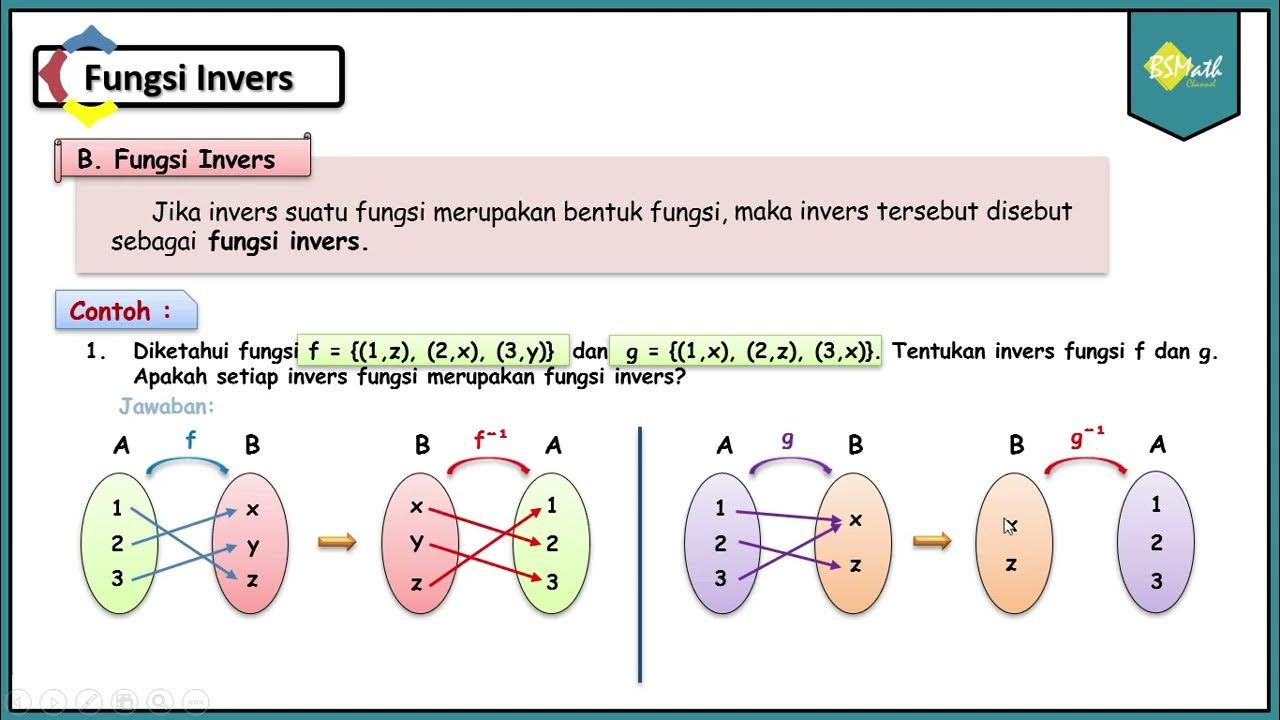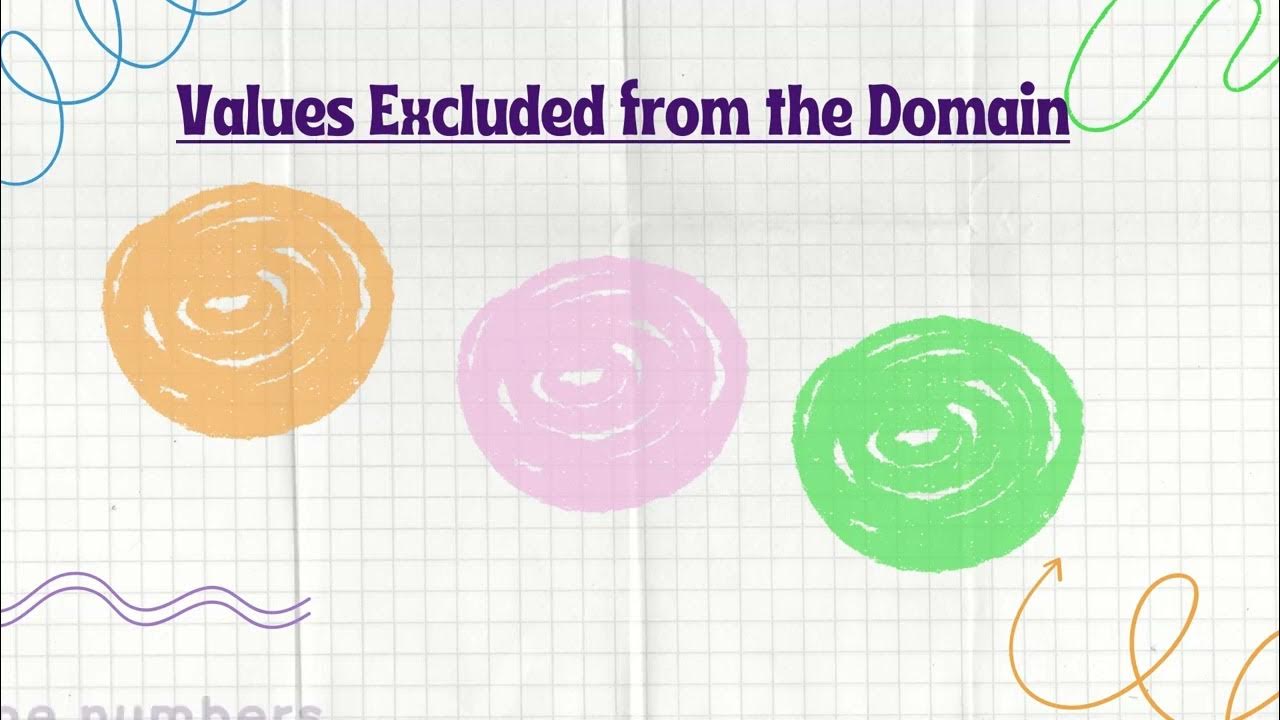Lec 44 - One-to-One Function: Examples & Theorems
Summary
TLDRThis video script explores the concept of one-to-one functions, providing examples to illustrate the concept. It begins by examining the modulus function, demonstrating it is not one-to-one using the horizontal line test. It then contrasts this with the linear function, f(x) = x, which is shown to be one-to-one. The script further delves into cubic functions, proving their one-to-one nature through the same test. The presenter also introduces the theorem that a function is one-to-one if no horizontal line intersects its graph more than once. Finally, the script identifies increasing and decreasing functions as classes of one-to-one functions, concluding with the notion that one-to-one functions are common and reversible, setting the stage for a discussion on exponential functions.
Takeaways
- 📚 The script discusses the concept of one-to-one functions, also known as injective functions, in the context of mathematics.
- 🔍 It uses the modulus function, f(x) = |x|, as an example to demonstrate that it is not a one-to-one function due to the same output for different inputs (e.g., f(2) = f(-2) = 2).
- 📈 The script explains the vertical line test to determine if a relation is a function, ensuring no vertical line intersects the graph more than once.
- 📉 The horizontal line test is introduced as a method to check if a function is one-to-one, where a horizontal line should intersect the graph at most once.
- 👍 The linear function f(x) = x is confirmed to be one-to-one because for any two different inputs x1 and x2, the outputs f(x1) and f(x2) are also different.
- 📊 The script suggests that cubic functions, represented graphically with an example, are one-to-one due to their nature of not intersecting with a horizontal line at more than one point.
- 📘 A theorem is presented: if any horizontal line intersects the graph of a function at most once, the function is one-to-one.
- 🔑 The proof of the theorem is outlined, stating that if a function is not one-to-one, a horizontal line will intersect its graph at more than one point.
- 📝 The class of functions that are one-to-one is explored, highlighting that strictly increasing or decreasing functions are one-to-one based on the horizontal line test.
- 📉 The script provides intuition for why increasing and decreasing functions are one-to-one, as they satisfy the condition that for any x1 < x2, f(x1) < f(x2) for increasing functions and f(x1) > f(x2) for decreasing functions.
- 🌐 The script concludes by emphasizing that one-to-one functions are common and can be reversible, setting the stage for further topics such as exponential functions.
Q & A
What is a one-to-one function?
-A one-to-one function, also known as an injective function, is a function where each input is mapped to a unique output, meaning no two different inputs will have the same output.
How can you determine if the function f(x) = |x| is one-to-one?
-You can determine if the function f(x) = |x| is one-to-one by using the horizontal line test. If no horizontal line intersects the graph of the function at more than one point, then the function is one-to-one. In the case of f(x) = |x|, it is not one-to-one because, for example, f(2) = f(-2) = 2.
What is the vertical line test, and how does it apply to the function f(x) = x?
-The vertical line test is a graphical method to determine if a curve is the graph of a function. If every vertical line intersects the curve at most once, then it passes the vertical line test and is a valid function. For f(x) = x, the vertical line test is passed because each vertical line intersects the line y = x at exactly one point.
Why is the function f(x) = x considered one-to-one?
-The function f(x) = x is one-to-one because for any two different inputs x1 and x2, the outputs will also be different (f(x1) = x1 and f(x2) = x2), meaning x1 ≠ x2 implies f(x1) ≠ f(x2).
What is the horizontal line test, and how does it relate to one-to-one functions?
-The horizontal line test involves drawing horizontal lines across the graph of a function and checking if any line intersects the graph at more than one point. If no horizontal line intersects the graph more than once, the function is one-to-one.
Can cubic functions be one-to-one? If so, under what conditions?
-Cubic functions can be one-to-one depending on their specific form and coefficients. A cubic function is one-to-one if it is strictly increasing or strictly decreasing, meaning that as x increases, f(x) also increases or decreases without any reversals.
What is the theorem stated in the script regarding the horizontal line test and one-to-one functions?
-The theorem states that if any horizontal line intersects the graph of a function at most in one point, then the function is one-to-one.
How can you prove that if a function is not one-to-one, it will intersect some horizontal line at more than one point?
-If a function is not one-to-one, there exist at least two different inputs x1 and x2 that yield the same output (f(x1) = f(x2)). By plotting these points on the graph and drawing a horizontal line at the level of the common output, this line will intersect the graph at both points (x1, f(x1)) and (x2, f(x2)), demonstrating the function is not one-to-one.
What class of functions are generally one-to-one?
-Increasing functions and decreasing functions are generally one-to-one. An increasing function is one where if x1 < x2, then f(x1) ≤ f(x2), and a decreasing function is one where if x1 < x2, then f(x1) ≥ f(x2).
Why are one-to-one functions considered abundant in nature and reversible?
-One-to-one functions are abundant because they represent a wide variety of mathematical relationships where each input corresponds to a unique output. They are reversible because knowing the output allows you to uniquely determine the input, which is a desirable property in many mathematical and real-world applications.
What is the next topic discussed in the script after one-to-one functions?
-The next topic discussed in the script is exponential functions.
Outlines

Esta sección está disponible solo para usuarios con suscripción. Por favor, mejora tu plan para acceder a esta parte.
Mejorar ahoraMindmap

Esta sección está disponible solo para usuarios con suscripción. Por favor, mejora tu plan para acceder a esta parte.
Mejorar ahoraKeywords

Esta sección está disponible solo para usuarios con suscripción. Por favor, mejora tu plan para acceder a esta parte.
Mejorar ahoraHighlights

Esta sección está disponible solo para usuarios con suscripción. Por favor, mejora tu plan para acceder a esta parte.
Mejorar ahoraTranscripts

Esta sección está disponible solo para usuarios con suscripción. Por favor, mejora tu plan para acceder a esta parte.
Mejorar ahoraVer Más Videos Relacionados

Fungsi Invers - Matematika SMA Kelas XI Kurikulum Merdeka

Kalkulus 1: Fungsi dan Grafik Fungsi

Functions

What is 3D Translation Explained in Hindi l Computer Graphics

INVERSE OF ONE-TO-ONE FUNCTIONS || GRADE 11 GENERAL MATHEMATICS Q1

Verifying inverse functions by composition | Mathematics III | High School Math | Khan Academy
5.0 / 5 (0 votes)
